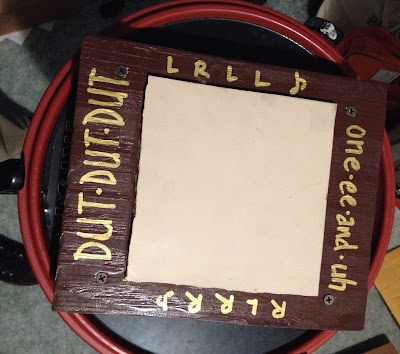When I was having health issues over this past winter, my counselor suggested I look at a meditative practice to help ease some of my symptoms and create a consistent way to begin my day.
I tried sitting still for five minutes, every morning.
That seemed doable. So I upped it to ten.
It got harder, but I hung in there.
I thought about upping it to fifteen, but my last day at ten minutes crashed and burned at around Minute Six. I was fidgeting and squirming and I couldn't sit still anymore.
So I gave up.
One morning after my failure, I was in the studio, fiddling with my sticks and a rubber practice pad (definitely a happy place). I pulled up my dog-eared copy of
Stick Control and opened it to the first page.
I set up my metronome at something stupid slow like 70 beats per minute, and forced myself to play the entire first page as instructed: each exercise twenty times without break before moving onto the next one.
So the whole point of Stick Control is that it's meant to be sequential, methodical and very gradual. You don't jump from Page One to Page Ten. (You could, but you won't really benefit as much from just burning through and sight-reading. This is not a sight-reading book.)
By the time I'd gotten through the entire first page at that speed, I noticed two things:
a. My hands felt jerky and klunky at the beginning, and pretty smooth and comfortable by the end of the page.
b. Repeating every figure twenty times before moving on at 70 bpm took me something like 10 whole minutes.
I knew I was onto something.
Every morning after that, after eating breakfast and taking my meds, I went into the studio and played the first page of Stick Control, at gradually increasing tempi with the help of a metronome.
When I was done with that, I decided I wanted to play something else. So I pulled up book number two:
128 Rudimental Street Beats, a collection of drum cadence figures from the 1960s, by John S. Pratt (a master drummer of the time and the head drum instructor at West Point).
These beats are deceptively simple.
I figured that, if I could nail down the snare drum part, I could then get the bass drum and cymbals in my little community band to play steady time, with beats on the quarter-notes. (None of them are experienced drummers and a couple don't read music at all, so I have to introduce new material by ear and repetition.)
What I discovered along the way of selecting two or three street beats I could string together is that these things are actually a lot of fun to play. I memorized a couple and have incorporated them into my morning drumitation.
Finally, if there was time left in my half-hour time limit, I'd pull out
my favorite solo book of all:
America's NARD Drum Solos, published in the
1940s and reprinted with fresh plates about 20 years ago.
The NARD Book was compiled by the first members of a new drumming organization formed in 1936, called the National Association of Rudimental Drummers. Their goal was to standardize the 26 basic rudiments (the "drummer's scales") known at the time and to encourage new drummers to adopt these standard rudiments as part of their training.
The original organization lasted until it disbanded in the late 1970s.
A new version of NARD was established in 2008 and remains active today. This book, now in its third edition, remains a gold standard for rudimental drummers around the world, and it's the book I learned from in high school. (I still have my old copy!)
I don't always work out of this book every morning -- sometimes I get lost in Stick Control and allow myself to just zone out, because the point of drumitation is to chill out and calm down, not to work up new material all the time. But when I reach for it there's always something more for me to learn.
I learned a couple of these solos for contest in school. Because I couldn't afford private lessons I figured them out myself, and was scolded for taking this approach at contest. "You're a good drummer," the judge told me. "If you're serious about your drumming you'll make finding a private teacher a priority." (This was back in the good old days when it was unseemly to admit that your Dad was looking for work and you were eating tuna casserole for the fourth night that week. So I kept my mouth shut and nodded. Then I went home I continued to play and work out stuff myself. I did not have a private drum teacher on a regular basis until I got to college.)
In my return to rudimental drumming I find that I'm sometimes paying for my lack of private instruction early on. But since my primary goal is to enjoy myself and to use rudimental drumming as part of a meditative practice, I don't worry about that. I'm not currently looking for a private teacher (and I can't afford one, anyway). And sometimes I don't get to the drum pad when I'd planned to so I end up doing it a little later in the day. But drumming on a rubber pad has definitely helped me musically and emotionally, and for that reason I'm grateful I can still play.















